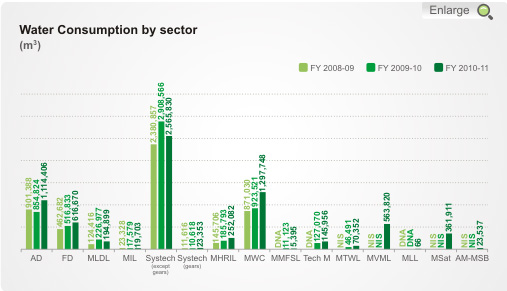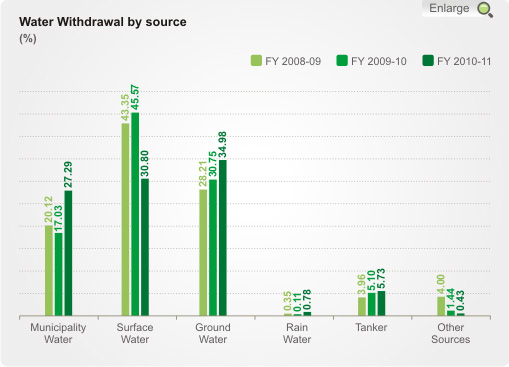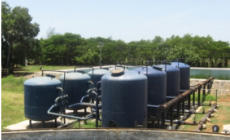| Environmental Performance |
 |
| |
| Water |
In spite of the fact that approximately 71% of Earth is covered by water, its 6 billion inhabitants can make use of only 1% of this water for their daily subsistence. With a rapid increase in industrial production and an accelerated population growth, water is witnessing a surge in demand like never before. Contamination of existing water bodies and depleting sources
of water is leading to conflict among various stakeholders for thus precious natural resource. We, at Mahindra, are sensitive to this scenario and have commenced a comprehensive water foot-printing exercise across the group. |
|
 |
| Most of our locations utilise municipal water for production and day to day activities. But in the absence of piped water, bore wells are dug on-site to tap ground water. The Mahindra Group ensures that water withdrawal at these locations does not pose any threat to water bodies, the surrounding water table, animals and humans. |
|
| |
 |
| |
| The water performance of the group, by sector, by location, by specific consumption and by source is detailed below. |
| |
| Highlights of Water Consumption |
|
| 1 |
The absolute water consumption has increased as compared to previous years due to
a significant increase in production/services this year across most sectors. |
| 2 |
Specific water consumption in seven sectors - Systech, MIL, MTWL, MLDL, MHRIL, MMFSL and Tech M, has shown a substantial decline compared to last year FD has recorded stable specific water consumption with a negligible 0.98% increase compared to
previous year. |
| 3 |
MWC posted an increase in specific water consumption compared to previous year due
to ongoing construction activities at Chennai and Jaipur locations. |
| 4 |
New projects under implementation stage at various locations of AD has resulted in the increase of specific water consumption this year compared to previous year. |
| 5 |
Significant improvement in data collection process as compared to previous years has resulted in increase in water consumption of Systech – Gears. |
|
| |
 |
| DNA-Data Not Available, NIS - Not In scope. |
|
| Specific Water Consumption |
(cubic meter/unit of measure) |
|
| |
Sector |
2008-09 |
2009-10 |
2010-11 |
% reduction in
2010-11 over
previous year |
 |
AD |
4.68 |
3.36 |
3.952 |
-18 |
| FD |
2.11 |
1.84 |
1.858 |
-0.98 |
| Systech (Except Gears) |
11.97 |
12.16 |
9.092 |
25 |
| Systech (Gears) |
0.006 |
0.005 |
0.009 |
-80 |
| MIL |
0.20 |
0.12 |
0.109 |
9 |
| MTWL |
NIS |
0.67 |
0.392 |
41 |
 |
MWC |
457.71 |
418.45 |
588.014 |
-41 |
| MLDL |
0.23 |
0.46 |
0.34 |
26 |
| MLL |
DNA |
DNA |
0.045 |
NA |
| MHRIL |
1.07 |
1.19 |
1.06 |
11 |
| MMFSL |
DNA |
27.88 |
18.04 |
35 |
| Tech M |
DNA |
4.39 |
4.07 |
7 |
 |
MVML |
NIS |
NIS |
13.767 |
- |
| MSat |
NIS |
NIS |
18.013 |
- |
| AM-MSB |
NIS |
NIS |
2.867 |
- |
|
| Note: NIS-Not in Scope. DNA - Data not available. |
|
 |
|
|
| Discharged Water Quality |
| All the water on our planet is connected in some way or another. The wastewater that is flushed down the sewer is capable of affecting the drinking water supply of the local population or the ground water tables of the surrounding area. Keeping this in mind, we have invested significant resources to set-up efficient discharge systems comprising robust ETPs (Effluent Treatment Plants) and STPs (Sewage Treatment Plants) to assist zero discharge of wastewater pollutants |
 |
|
| The wastewater is monitored both internally and through external agencies. The discharged water is regularly analysed for C.O.D, B.O.D, pH, and other parameters specified by regulatory authorities. The values are always been found to be within the limits defined by the State Pollution Control Boards and local statutory authorities. |
|
|
AD-Nashik |
|
| |
49 water conservation methods
like rain water harvesting and
usage of treated water. |
|
| |
Mahindra World City Developers Ltd. |
|
| |
MWCDL has an in-house Sewage Treatment
Plant (STP) with a capacity of 2 million gallons per day (MGD) capacity and a Tertiary Treatment Plant (TTP) of 1 MGD. We ensure that 100% of waste water generated within the project is treated by these plants. The treated water is used to meet
the 100% requirement of irrigation for landscaping within MWCDL. In addition to this, MWCDL has incorporated drip irrigation network to water
around 5,000 trees. |
|
| |
At present, for our complete irrigation requirement,
it is utilizing only 8% of the STP's capacity. Based on trends, it is estimated that the STP will reach 100% operational capacities in 2018. Thus, we ensure that would reuse 100% of the treated wastewater generated within Mahindra World City. |
|
|